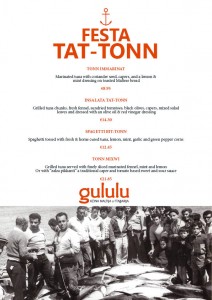As recently as 1961 each year in the spring and the autumn fishermen set up the “Tunnara” in Mellieha Bay or in Anchor Bay ( this name was given by the British colonisers who were impressed by the very large anchors which were lowered to keep the “Tunnara” secure), and sometimes below the cliffs of Selmun . The “Tunnara” a pretty simple contraption of nets into which the migrating tuna would swim into and be trapped, then caught saw its last day when a Royal Navy frigate cruised through it one dark night and tore it to shreds. Since then tuna has been fished by other methods ensuring still adequate catches to satisfy the local demand for its delicious meat, and although once threatened, as industrial scale fishing set up to satisfy the lucrative Japanese market since the 1980s greatly depleted the stock, EU imposed legislation regulating catch quotas have since helped to stabilise matters. This year the quota has been increased by 20% and this is good news for fishermen, restaurant chefs and housewives too.
In days gone tuna was cooked “well done” as refrigeration was often inadequate and unreliable. This method of cooking rendered the fish dry and and sauces were used to keep it moist. Today tuna is mostly eaten in a raw or semi-raw state in restaurants around the world which it often takes a few days to reach. In Malta tuna is eaten the same day it is landed or 24 hours later at most. Many restaurants are close to the sea or as in the case of Cuba bistro and Gululu in Spinola Bay literally a jump away. In other words one couldn’t choose a better place to eat tuna in.
Both of these St. Julian’s restaurants celebrate the tuna season with a “Festa tat – Tonn” dedicating a supplement to their menu which includes only tuna dishes. At Gululu, the casual Maltese diner which cooks both traditional Maltese as well as contemporary dishes using typical ingredients, offers a mix of trusted home recipes and the chefs’ creations. Cuba, free to wander within the scope of an international cuisine, prepares a mixture of Mediterranean and Latin American dishes. Whichever one goes for, one is assured of tasting the freshest tuna prepared with passion by some of Malta’s most talented young chefs. It is helpful that both restaurants print one “Festa” menu and therefore whilst enjoying one’s tuna in one restaurant today one can muse over and look forward to the next day’s dinner.

